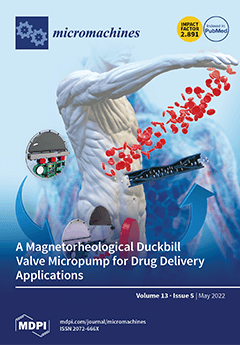Efficient printing frequency is critical for thermal bubble inkjet printing, while the difficulty lies in the structural design and material selection of the heating resistors. In this paper, a TaN film was used as the main material of the heating resistors, and two
[...] Read more.
Efficient printing frequency is critical for thermal bubble inkjet printing, while the difficulty lies in the structural design and material selection of the heating resistors. In this paper, a TaN film was used as the main material of the heating resistors, and two TaN films were placed in parallel to form the chopsticks-shaped structure. The heating time was divided into two sections, in which 0–0.1 μs was the preheating and 1.2–1.8 μs was the primary heating. At 1.8 μs, the maximum temperature of the Si
3N
4 film could reach about 1100 °C. At the same time, the SiO
2 film was added between the TaN film and Si
3N
4 film as a buffer layer, which effectively avoided the rupture of the Si
3N
4 film due to excessive thermal stress. Inside the inkjet print head, the maximum temperature of the chamber reached about 680 °C at 2.5 μs. Due to the high power of the heating resistors, the working time was greatly reduced and the frequency of the inkjet printing was effectively increased. At the interface between the back of the chip and the cartridge, the SiO
2 film was used to connect to ensure a timely ink supply. Under the condition of 12 V at 40 kHz, the inkjet chip could print efficiently with 10 nozzles at the same time. The inkjet chip proposed in this paper is not limited to only office printing, but also provides a new reference for 3D printing, cell printing, and vegetable and fruit printing.
Full article






